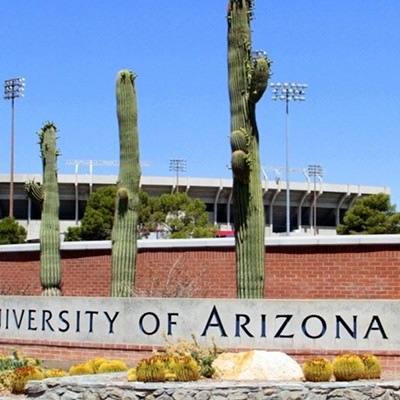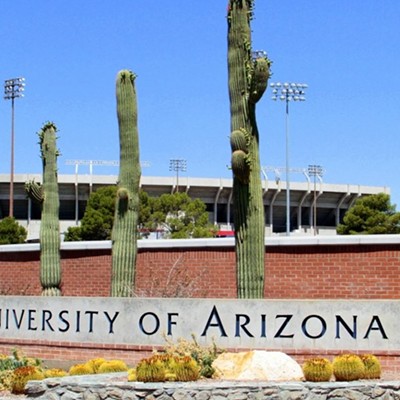The former provost at the University of North Carolina, Chapel Hill was 20 minutes late to a scheduled appointment with the Weekly, because he was taking an important phone call from the Arizona Board of Regents.
And the interview was cut short soon after his administrative assistant stepped in to say his next appointment had arrived. (She had to scour his date book to squeeze in the interview in the first place. "It's like trying to get a 10-pound bag of sugar into a thimble," she said about Shelton's time constraints.)
But despite a schedule that's bursting at the seams, or perhaps as a result of it, the general consensus seems to be that Shelton is settling in nicely.
"He was my favorite candidate; I can say that easily," said Gail Burd, associate dean for the College of Science. "I don't know anybody who's unhappy about the choice (of Shelton)."
Tommy Bruce, chief of staff for student body President Erin Hertzog, echoed that sentiment.
"I was extremely impressed," he said, after a brief meeting with the new prez. "He was very personable. He seemed to have a great outlook on the future of the university, how he's going to handle the different issues that we're looking at. He seemed, by far, the best choice that we could have picked."
Unsurprisingly, Bruce said tuition costs and class availability were the issues foremost on students' minds, but he felt like Shelton was someone who was going to listen. "He's open and prepared to take the student perspective, and he wants the student perspective to see what they think the issues are," he said. "That's, I think, the best outlook and best approach he can take."
Talking to the Weekly in his wood-paneled, seventh-story office in the UA Administration Building, an upbeat Shelton said he was hard at work preparing to speak with regents on Aug. 10, the day after the interview.
"This is a particularly important meeting for me," he said. "It's my first one, and I will be in an executive session with the regents only. It's called a review of assignments. So I have, I don't know, 15 to 20 minutes to tell them what's on my mind, where I think I'm going to be spending my time this year. And they have a chance to tell me if I've got it right and suggest other issues that I might have to deal with."
Shelton also said he was going to be giving a presentation on what it means for the UA to operate under the "enterprise model," in contrast to the "agency model," which he described as a kind of bureaucratic-entitlement system in which "you don't have to be creative."
"I'm looking forward to that, because it's a particularly satisfying kind of presentation, since a research university--a world-class research university like UA--has been an enterprise model since its inception," Shelton said. "That's why we have things like the Steward Observatory, the tree-ring laboratory, why (we have) Professor (Mark) Riley and his new idea with the RediRipe sticker that goes on fruits and vegetables. That is the definition of enterprising."
Shelton said he and the two other public-university presidents in the state would be talking with regents about "metrics or measures of excellence." The new president of the Board of Regents, Robert Bulla, comes from a corporate background, Shelton continued, and is interested in getting a handle on progress and success at the state's universities.
"Some things are easy, right?" Shelton said. "You can look at your research dollars. You can say, 'We brought in $50 million more last year than the previous year.' ... You can say, 'We're graduating more Ph.D.s. More of our law graduates passed the bar (exam) on their first try.'
"But some measures of outcomes are more difficult. For example, tracking your undergraduates--where do they go? Are they successful? Are they getting good career placements? Are they getting into the graduate or professional schools they want? And so we're going to talk about what we use here at the University of Arizona, and things that we might add on or do a little bit different."
One success Shelton highlighted stemmed from the university's use of money dispersed by the regents-administered Technology and Research Initiative Fund, also known as TRIF. He said the university intended to show the board in its annual report that the funds were being put to good use.
The TRIF money comes from voter-approved Proposition 301 (in 2000), which provided for a 0.6 percent increase in the state sales tax to go toward education. A portion of those funds went to the universities to nurture innovation.
"It's supposed to be used to incentivize and to do new things that will have a good return on investment," Shelton said.
The UA's share of TRIF money this past fiscal year was about $23 million, according to Leslie Tolbert, vice president for research, graduate studies and economic development. Each university spends its money differently; the UA uses it on three research initiatives and a number of educational and research-infrastructure programs.
The goal of the research initiatives is to foster workforce development and the translation of scientific ideas into practical applications. The first two research initiatives focus on optics and water sustainability. BIO5, the third and largest of the research initiatives, is a collaborative bioscience institute, bringing together scientists from a variety of disciplines "to solve complex biological problems," as its Web site put it.
The TRIF funds have allowed the research initiatives to hire people now, instead of waiting until other sources of funding become available, Tolbert said. It's also permitted the university to entice talented scientists by engaging in what Tolbert called "cluster hiring," or hiring groups of researchers who might not have been lured to the university individually.
"If that person knows that you're also hiring two or three other people simultaneously, and all of them are going to be working in the BIO5 building--even though their home departments will be scattered across campus--then you're more likely to get really good groups," she said. "So it's allowed us to do something we couldn't possibly have done without the TRIF funds. It's fantastic; it's really making a difference."
The number of researchers brought in by the research initiatives has varied from year to year. BIO5, for example, has hired between five and eight new faculty members each year during the past few years. In the fiscal year ending July 1, they'd hired half a dozen.
Once these talented researchers are brought on board, Tolbert said, they start generating their own sources of funding through grants. "And we don't need TRIF funds forever," she said. "That's the idea."
During the interview, Shelton said the state did so well financially last year that the UA has been asked to come up with ideas on how to spend extra TRIF money, totaling about $12 million. In fact, the Board of Regents later approved a proposal to devote $1.5 million in excess TRIF funds to accelerate the expansion of the UA College of Medicine in Phoenix.
When Shelton came into office at the beginning of July, the Arizona Daily Star ran a story in which reporters asked 32 "administrators, faculty, staff, students, alumni, Tucson business leaders, elected officials and campus-area residents" about what the new president's priorities should be. No. 1 on the list was the expansion of the medical school in Phoenix.
"One of the things we're focusing on is how to accelerate the College of Medicine and biomedical campus facilities up in Phoenix," Shelton said. "It's pretty exciting right now. I guess you can look at the doughnut, or you can look at the hole, right? The doughnut is that a lot has been done. Buildings will be ready for occupancy next month; a couple of them are already."
The Phoenix Union High School downtown is being adapted to house the first class of medical students. Shelton, who grew up in the Valley of the Sun, said he remembered a time when it was the biggest high school west of the Mississippi River. Now, that space will provide room for some 24 medical students.
"It will allow us to have a strong presence in a huge and growing metropolitan area, and that ties in with a lot of very important and powerful health care providers: Banner, St. Joe's, Maricopa County, the VA (Veterans Administration)," he said. "So that allows us to attract even better faculty. It will bring increased national visibility, both in terms of size and quality, to medicine and, I think to other programs. We're planning on having a presence of our College of Pharmacy up there, because medicine and pharmacy couple so well together. I would envision public health and other programs having satellites in that area."
But there are still challenges, Shelton said.
"The 'hole' part is we still have to work hard to get sufficient dollars, whether they're dollars to build new buildings or dollars to operate the school," he said. "And so one of the proposals that (ASU President) Michael Crow and I are putting together is to use some of these TRIF dollars--a modest amount, a million (or) a million and a half--to accelerate the planning, to try to move it forward more aggressively.
"I think for many, many months--maybe years--there were doubters about whether this would work. Now that we have buildings in place, now that we have accreditation coming online, now that we're recruiting our first class of students, now that we have faculty appointed up there--both from the UA and adjunct appointments from ASU--people are realizing that this is going to happen. And we need to continue to make people realize that it's going to happen by showing this kind of concrete progress. So it's exciting, but not without challenges."
Shelton starts his term as president on the heels of several rounds of budget cuts that were necessitated by slashed funding from the state Legislature. He said his predecessor, Peter Likins, put together an excellent budget-stabilization plan "to dig out of some holes," but he acknowledged the cuts still stung.
"We're not unique," Shelton said. "That's happened across the country. I cut $100 million out of the budget back at Chapel Hill. About half of that was permanent, and about half of that was one-time. It's very painful, and then you have to figure out how to continue to function."
Shelton talked up the virtues of fiscal discipline and avoiding digging more holes. But that could be complicated by the lack of growth in the student body, as that's one of the factors in determining funding. Enrollment at the UA has hovered around 37,000 since 2002, while Arizona State University is racking up explosive growth. In the 2005-2006 school year, for example, ASU added 3,000 students over the previous year.
Shelton said he has asked what the UA facilities can handle in terms of growth and for models and projections of income received from students, in order to see if the university will have the revenue to hire instructors.
"So size is a question," he said. "We have to grow to serve the state. I mean, this isn't North Dakota, where the population is stable. People want to come here."
And then there's the issue of maintaining competitive salary levels. Grant proposals to get outside funding for research don't write themselves; you need talented faculty members to do them, said the College of Science's Burd.
"A challenge is to have faculty salaries that are competitive with our peer institutions, so that we don't lose faculty--who can write these kinds of grants and do this kind of research--to Cal Tech and other institutions like that," she said.
Figures supplied by the UA Office of Institutional Research and Evaluation show pay rates for full professors at the university are, on average, about 10 percent below the average rates for colleagues at peer institutions--and have been since at least 2000.
"People from any walk of life can understand the importance of attracting and keeping the best people," Shelton said. "If you run a business, that's what it's all about. My view is that we have to tap a lot of different sources. One of the great ways to keep people here is to have endowed chairs. It doesn't have to pay a huge amount of money, but it tops up what the state can do. And it's the prestige--we need more endowed chairs."
The uncertainty of future funding will continue to be an issue, although Shelton said he'd like to thank the Legislature for the strong budget they provided him with this year.
Burd, who has been a UA professor for two decades, said she saw a lot of growth in the sciences when she first came here, which was then nipped when the Legislature tightened its belt in leaner times. The money that was cut wasn't replaced by the Legislature when times got better again, Burd said.
"I think they (legislators) don't quite understand what a jewel they have," she said. "I tried to explain to a previous mayor in Tucson--when I was trying to get support for the science programs--I was saying, 'You know, what you don't understand is that we bring money that could have gone to Kansas.' I am a small-businessperson. I run a lab, and I bring money to the university that could have gone anywhere else in the country. I hire people, so I'm actually running a small operation here that brings a lot of money to Tucson, and you get taxes on that.
"I think they haven't quite understood that very much."
In order to make Arizonans understand what a jewel they have in Tucson, Shelton plans to spend a significant amount of time on publicity efforts during the upcoming year. In addition, the search is on for a university vice president in charge of external relations--a position he said has been "vacant for a long time."
"Not enough people know what goes on at this university," Shelton said. "It is a tremendous university; I know, because I go to provost and president's meetings around the country, and I hear about it. But, in fact, we are almost too shy in bragging about ourselves.
"I figure I'm new, and I can't take credit for any of this, so I can brag shamelessly about what's going on here."










